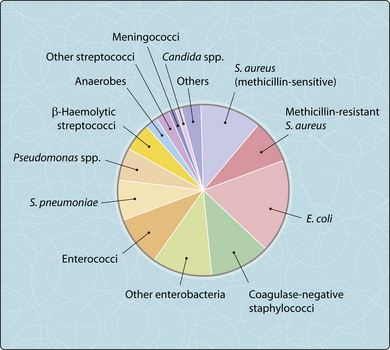28. Septicaemia
Aetiology
There are a number of different risk factors associated with community- or hospital-acquired septicaemia. The incidence of many community-acquired infections has changed little in recent years, and typical risk factors are urinary tract infection, pneumonia, diabetes and old age. Common organisms are Escherichia coli, Neisseria meningitidis, Streptococcus pyogenes, Streptococcus pneumoniae and, in some countries, Salmonella typhi. In hospital-acquired infections, the increase in invasive procedures (intravascular lines, prosthetic implants or urinary catheters), immunosuppressive therapy and broad-spectrum antimicrobial drugs has led to an increase in the proportion of Gram-positive isolates, especially coagulase-negative staphylococci, although Gram-negative isolates (Pseudomonas spp. and enterobacteria) are also not uncommon. Figure 3.28.1 shows the organisms isolated in a large teaching hospital laboratory.
< div class='tao-gold-member'>














